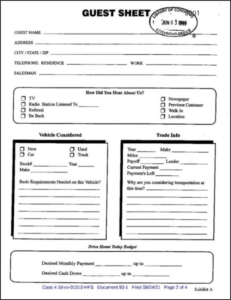The US Court of Appeals for the Eighth Circuit affirmed a district court’s judgment that a customer intake form was not copyrightable because it lacked requisite originality. Ronald Ragan, Jr. v. Berkshire Hathaway Automotive, Inc., Case No. 22-3355 (8th Cir. Feb. 2, 2024) (Grasz, Smith, Gruender, JJ.)
Ronald Ragan claimed that he owned the Guest Sheet, a form he designed to aid car dealerships in their sales processes. The form, registered with the US Copyright Office in 1999, included various questions, prompts, headings, fill-in-the-blank lines and checkboxes. Ragan initially accused an auto dealership of copying and using the Guest Sheet. However, subsequent legal action regarding the dealership’s alleged infringement was dismissed because of jurisdictional issues.

Five years later, Berkshire Hathaway Automotive acquired the dealership. Berkshire Hathaway continued to use the Guest Sheet post-acquisition despite Ragan’s objections. Allegedly, Berkshire Hathaway agreed to modify the form but continued to use it, prompting Ragan to initiate a copyright infringement lawsuit. Berkshire Hathaway moved for judgment on the pleadings, contending that the Guest Sheet was not copyrightable. After the district court granted the motion, Ragan appealed.
Ragan argued that the district court erroneously found the Guest Sheet uncopyrightable. The Eighth Circuit disagreed, stating that the Guest Sheet lacked the necessary originality to qualify for copyright protection. Despite Ragan’s contentions regarding the form’s sophistication distilled from years of experience, the Court found it to be a basic customer intake sheet with minimal creativity, consisting of simple questions, prompts and checkboxes and totaling fewer than 100 words. Citing and quoting from the 1991 Supreme Court decision in Feist Publ’ns. v. Rural Tel. Serv., the Eighth Circuit explained that to be copyrightable, a work must possess a minimal degree of originality: “To meet this [originality] requirement, a work must be ‘independently created by the author (as opposed to copied from other works), and . . . possess[] at least some minimal degree of creativity.’”
The Eighth Circuit rejected Ragan’s argument that the selection and arrangement of words on the Guest Sheet constituted sufficient originality, emphasizing the need for creativity beyond mere selection. The Court also noted that the Guest Sheet primarily served as a tool for collecting information rather than conveying substantial content, further diminishing its claim to copyright protection.
Ragan also argued that the Guest Sheet’s copyright registration certificate afforded it a presumption of validity. However, the Eighth Circuit rebuffed this argument noting that Berkshire’s challenge to Guest Sheet’s copyrightability could be based solely on examination of the form itself, notwithstanding the presumption of validity attendant to the registration certificate.
Practice Note: This decision highlights the importance of demonstrating substantial creativity in crafting documents for potential copyright protection and emphasizes that mere selection and arrangement of words may not suffice. Legal proceedings can hinge on the functionality and purpose of a document, as evidenced by the court’s distinction between information-conveying and information-capturing forms in determining copyrightability.
read more


 Subscribe
Subscribe


